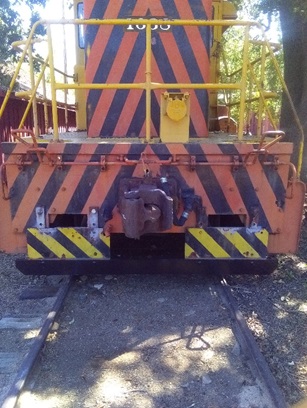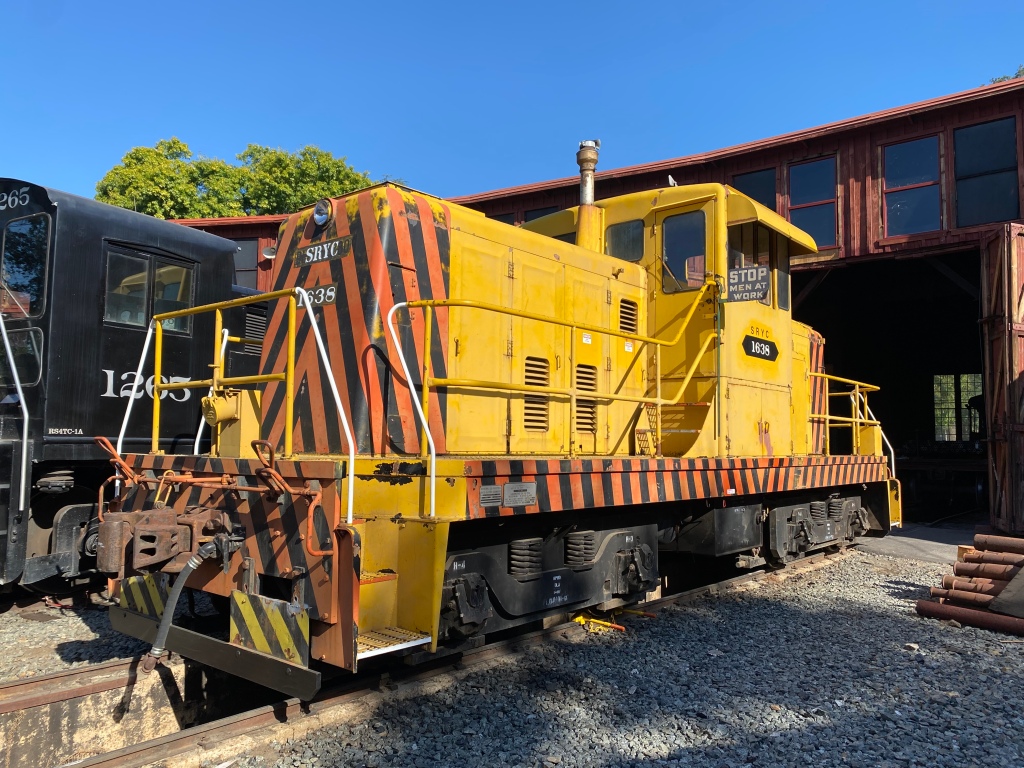Several important tasks were undertaken on locomotive No. 1638 during the summer, and a few notable milestones were achieved. One of the last significant tasks was to review and complete the checklists for a number of federally-mandated inspections. Normally, a diesel locomotive like No. 1638 must be inspected at regular intervals, with the inspection requirements becoming increasingly rigorous as the inspection interval increases. For example, in-service diesel locomotives must be inspected every 92 calendar days, 368 calendar days, and in the case of No. 1638, every 736 calendar days. The list of items to inspect on a 92-day inspection is only one page, whereas a 736-day inspection is quite extensive, and comprises a list that’s several pages long. In anticipation of returning the locomotive to active duty, it was decided to complete all of the inspections and activities needed. This would assure that nothing would be overlooked, and that future record-keeping could start with a solid foundation. So, over the course of a few weeks, the checklists were filled out line-by-line, until all of the inspecting, measuring, cleaning and replacing had been taken care of. Amazingly, no “surprises” were found, and the paperwork was signed off and filed.
Like many aspects of the railroad industry, the Federal Railroad Administration (also known as the FRA) prescribes standards for the design, safety and operation of locomotives. Looking over the requirements for diesel locomotives, it was discovered that the ends of No. 1638 did not comply with the minimum standards that the FRA set forth. Specifically, diesel locomotives must have some sort of end plate (a flat metal plate, a snow plow, or even a “cow-catcher” style pilot) that is no more than six inches above the top of the track. As it turned out, one end of No. 1638 was just out of compliance at 6.5 inches, while the other end was measured at 7.5 inches. Additionally, the end plate is required to extend across both rails, but the ones on #1638 had a large gap in the middle. In order to ensure the locomotive was in compliance with federal regulations, new white oak lumber of the correct height was ordered, milled, painted and installed on the ends of the locomotive. The old pieces were placed into storage, and another regulatory item was successfully addressed.


From the very beginning of the project, it was anticipated that the primary purpose of No. 1638 would be to act as the Jamestown yard-switcher, but recent discussions among project and State Parks staff led to the conclusion that it would be important to make the locomotive available for road service as well, in case a “rescue engine” or a substitute for the “Mother Lode Cannonball” is needed. To comply with FRA regulations, this meant one major requirement: the locomotive needed an Emergency Brake Valve that could be operated on the opposite side of the cab, from the Engineer. Because No. 1638 had been designed as a switching engine, there was no valve on the “left” side of the cab, and was not compliant to operate in road service. To correct this, measurements were taken, and plans were drawn up to install an Emergency Brake Valve on the side of the electrical cabinet in the locomotive cab. Not only did this involve the purchase of a number of specialty parts and fittings, but also required several weeks of extensive pipe-fitting, threading and plumbing work. At the time, Railtown’s modern pipe cutting/threading machine was being repaired, so all of this work had to be done by hand. By mid-summer, the valve was installed and painted, and the required “Emergency Brake Valve” label had been applied. A few different tests showed the valve and plumbing worked as intended, with no major leaks or issues.

With a majority of the regulatory necessities taken care of, it was time to request a visit from a Motive Power & Equipment Inspector from the FRA. Although an inspection from an MP&E inspector is not required to return a diesel locomotive to service, voluntarily inviting FRA inspectors is a wise practice. Not only does it help provide a set of trained eyes to identify any potential issues that may have been overlooked, but it shows the federal regulators that you have an open and honest maintenance program, and are willing to share, listen, and learn. When the FRA inspector showed up near the end of August, it was straight to business. Restoration Specialist Matt Sagaser and myself accompanied the inspector for a couple of hours, as he climbed all over, in, and under No. 1638. Armed with a measuring tape and notebook, the inspector took several measurements, while asking numerous questions and verifying information. When all was said and done, the inspector said he was “very impressed” with the locomotive specifically, and the project in general. However, he did find a couple of items that had been overlooked, and would need to be addressed before the locomotive could be placed into service.
One item that the inspector noted was that the handrails along the locomotive’s end steps were painted the same color as the rest of the body. The inspector clarified that even though No. 1638 would be listed in regulatory documents as a road-service locomotive, it would also need to meet the requirements and standards of a switching locomotive, so the handrails and bottom steps would have to be painted a contrasting color from the locomotive’s body. Over the course of a few days, all of the locomotive’s end-step handrails were painted gloss white. An additional day was spent painting the edge of the four bottom corner steps. The result is a locomotive that is safer to run, easier to see, and of course, compliant with federal regulations.

The other item that the inspector mentioned involved the testing of two of the locomotive’s electrical gauges. Although project staff had tested the gauges according to regulation, the FRA inspector preferred a different method, utilizing modern testing instruments. Since the MP&E inspector is ultimately the person who can decide a locomotive’s compliance, it is important to follow their advice. After getting recommendations from the inspector, a brand-new testing/calibration device was ordered. Each one of these machines is custom-built, and takes over a month to assemble and ship. It is hoped that Railtown’s will arrive before winter, and the very last of the regulatory requirements will be completed. When that’s done, the locomotive can be officially signed off, and the project can finally progress to its final phase: Operation and Road Testing.

Stay tuned for more updates, as we reach closer and closer to our conclusion!

